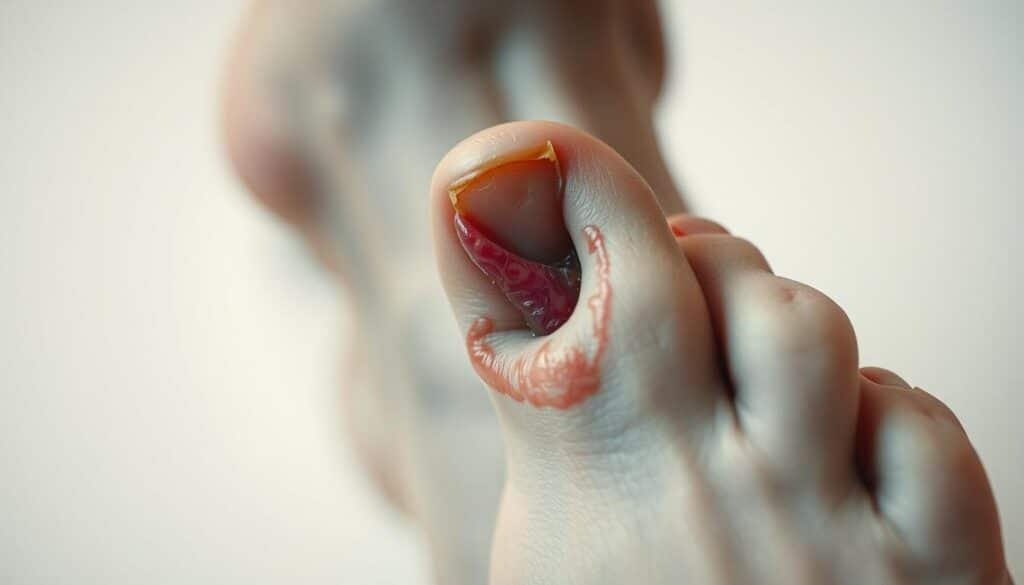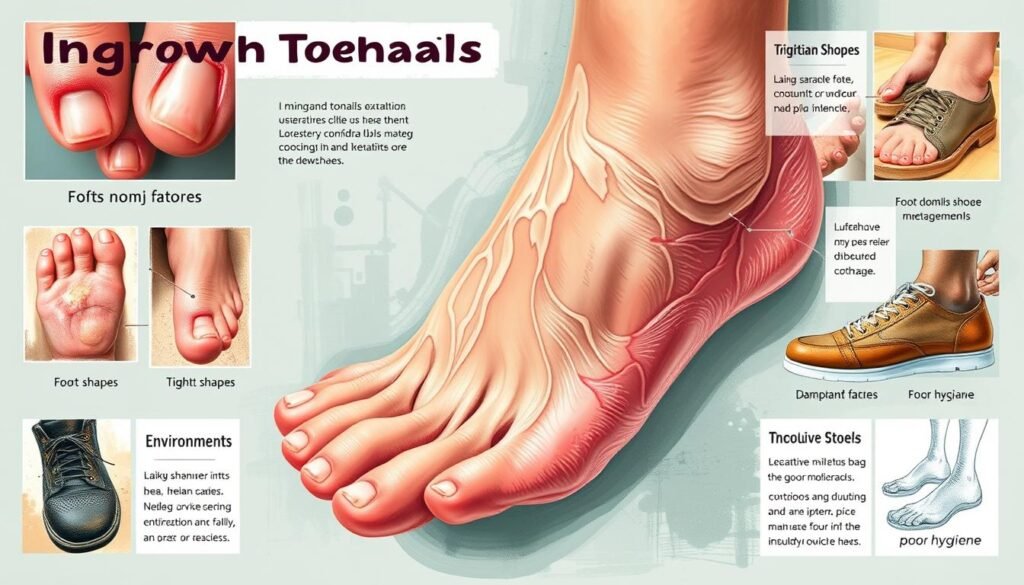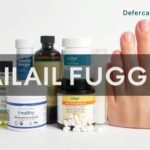Ever felt a nagging pain in your toe that won’t go away? You might have an ingrown nail, a common but often misunderstood foot issue. Ingrown toenails happen when your nail grows into the skin around it, causing pain and possible complications. Let’s explore the world of nail growth problems and find out what really causes ingrown toenails.
Improper nail trimming is a big reason for this problem. Cutting your nails too short or rounding the edges makes the nail grow into the skin. Wearing tight shoes can also push your toes together, making the problem worse. Injuries to your toes can lead to abnormal nail growth, causing an ingrown toenail.
It’s important to spot the early signs. You might see tenderness, swelling, or redness around your toenail. As it gets worse, you could feel more pain, warmth, or even see discharge. Don’t ignore these signs – acting early can stop the problem and save you from a lot of pain.
Key Takeaways
- Big toes are most commonly affected by ingrown nails
- Cutting toenails too short is a leading cause
- Ill-fitting shoes contribute to ingrown toenail development
- Early symptoms include pain, swelling, and redness
- Home remedies can help minor cases
- Severe cases may require professional medical treatment
- Prevention involves proper nail care and appropriate footwear
Understanding Ingrown Nails: Definition and Prevalence
Ingrown nails are a common foot problem that can cause discomfort and pain. They occur when the corner or side of a nail grows into the surrounding soft flesh. Let’s dive into what ingrown nails are, how common they are, and which toes are most affected.
What are ingrown nails?
Ingrown nails happen when the edge of your nail grows into the skin instead of over it. This can lead to inflammation, pain, and sometimes infection. Curved nails are often a contributing factor to this condition. Doctors classify ingrown nails into three stages based on severity:
- Stage 1: Nail growth into the skin causing inflammation
- Stage 2: Inflamed tissue around the nail with weeping and pus
- Stage 3: Chronic inflammation with pus oozing from the skin
How common are ingrown nails?
Ingrown nails are quite prevalent. Studies show that 20 out of 100 people visiting their family doctor for foot problems have an ingrown nail. The overall prevalence ranges from 2.5% to 5% of the population. Teenagers and young adults are more prone to this condition due to increased sweating and engagement in sports activities. There’s a clear male predominance, with a male to female ratio of about 2 to 1.
Which toes are most affected?
While any toe can develop an ingrown nail, the big toe is by far the most susceptible. In fact, ingrown nails occur almost exclusively on the hallux (big toe) nails. The lateral edge of the toe is affected twice as often as the medial side. Understanding these toenail ingrowth reasons can help you take preventive measures and seek timely treatment when needed.
Remember, proper foot care, including correct nail trimming and wearing well-fitting shoes, can go a long way in preventing ingrown nails. If you experience persistent issues, don’t hesitate to consult a podiatrist for professional care.
What Causes Ingrown Nails: Common Factors

Ingrown nails happen when a nail grows into the skin around it. Many things can cause this painful issue. Knowing what causes it can help you avoid and treat ingrown nails.
One big reason is cutting your nails wrong. If you cut them too short or round the corners, the nail might grow into the skin. Wearing tight shoes is another problem. These shoes push your toes together, making the nail grow in weird ways.
Getting hurt on your toes can also mess up your nail growth. Not keeping your feet clean can make your nails and skin soft. This makes it easier for the nail to get into the skin. Activities like running or ballet can also make your feet stressed, raising your risk of ingrown nails.
| Cause | Impact | Prevention |
|---|---|---|
| Improper nail trimming | Encourages nail to grow into skin | Cut nails straight across |
| Tight shoes | Crowds toes, forces abnormal nail growth | Wear properly fitting shoes |
| Toe injury | Damages nail bed, leads to irregular growth | Wear protective footwear |
| Poor hygiene | Softens nail and skin | Keep feet clean and dry |
Teenagers often get ingrown nails because their feet grow fast and they’re active. If you have diabetes, you’re more likely to face serious problems from ingrown nails. The American Diabetes Association says it’s key for people with diabetes to check their feet every day to spot issues early.
Recognizing the Symptoms of Ingrown Toenails
Ingrown toenails can be very painful and may cause nail growth problems if not treated. It’s important to know what causes them and their symptoms. This helps in early treatment and prevents worse problems.
Early Signs of Ingrown Nails
The first signs of an ingrown toenail include:
- Tenderness along the toe’s sides or corners
- Mild swelling around the affected area
- Redness of the skin adjacent to the nail
- Slight pain when pressure is applied
Advanced Symptoms Indicating Infection
As it gets worse, symptoms can get more serious:
- Increased pain and throbbing sensation
- Warmth in the affected area
- Overgrown skin around the toenail
- Pus formation or drainage
- Bleeding when touched
When to Seek Medical Attention
See a doctor if you have:
- Severe pain that interferes with daily activities
- Signs of infection spreading beyond the toe
- Recurring ingrown nails despite home care
- Any symptoms if you have diabetes or poor circulation
| Symptom Severity | Recommended Action |
|---|---|
| Mild discomfort | Home remedies (soaking, proper trimming) |
| Moderate pain, redness | Over-the-counter treatments, careful monitoring |
| Severe pain, signs of infection | Immediate medical attention required |
Spotting and treating ingrown nails early can stop them from getting worse. If you’re not sure about your symptoms or they keep coming back, see a podiatrist. They can give you the right advice and treatment.
Risk Factors and Complications of Ingrown Nails

Knowing why ingrown toenails happen can help you avoid them. Many things can make you more likely to get an ingrown nail. For example, teens and young adults, especially guys between 14-25, are more at risk.
Not taking good care of your nails can cause problems. Cutting them too short or rounding the edges is a big no-no. Wearing tight shoes or doing activities that put pressure on your toes also increases your risk. People with sweaty feet, diabetes, or obesity are more likely to get ingrown toenails too.
Ignoring an ingrown nail can lead to bigger issues. Infection is a common problem, affecting the tissue around the nail and sometimes the bone. Look out for signs like redness, swelling, warmth, pain, and pus. In severe cases, untreated ingrown toenails can cause:
- Cellulitis
- Osteomyelitis (bone infection)
- Foot ulcers
- Permanent nail deformities
For people with diabetes or poor circulation, these complications are especially serious. If you have ongoing pain, signs of infection, or a chronic health issue, see a doctor right away. Early treatment can stop severe problems and help your nail heal properly.
| Risk Factor | Percentage |
|---|---|
| Foot problems due to ingrown toenails | 20% |
| Success rate of ingrown toenail surgery | 98.5% |
| Patients visiting doctors for ingrown toenails | 20% |
Home Remedies and Self-Care for Ingrown Nails
Ingrown nails can be painful, but there are ways to ease the discomfort at home. You can try home remedies and self-care before seeing a doctor. These methods can help with mild cases of ingrown toenails.
Proper foot soaking techniques
Soak your feet in warm, soapy water for 15-20 minutes, 3-4 times a day. This can help reduce swelling and tenderness. It softens the skin and nail, making it easier to handle the ingrown nail.
Nail lifting methods
Use dental floss or a small piece of cotton to gently lift the ingrown nail edge. Place it under the nail edge to encourage proper growth. This method helps separate the nail from the skin and prevents further ingrowth.
Over-the-counter pain management
To ease pain, take acetaminophen or ibuprofen. These can help manage the pain from ingrown nails. But, avoid hydrogen peroxide on your skin as it’s not recommended.
Appropriate footwear choices
Wear open-toed shoes or those with plenty of toe room to avoid pressure on the nail. Tight shoes can make the problem worse. Keep your feet dry and apply antibiotic cream to prevent infection.
| Home Remedy | Frequency | Benefits |
|---|---|---|
| Warm water soak | 3-4 times daily | Reduces swelling, softens skin and nail |
| Nail lifting | As needed | Promotes proper nail growth |
| Pain relievers | As directed | Manages discomfort |
| Proper footwear | Daily | Reduces pressure on affected nail |
Remember, taking care of your nails is key to avoiding ingrown nails. Trim them straight across and avoid rounding the corners. If the problem doesn’t get better or gets worse, see a healthcare professional for more help.
Medical Treatments and Surgical Options
When home remedies don’t work, you might need a doctor’s help. They might give you antibiotics if you have an infection. For minor cases, they might use a splint to help the nail grow right.
For serious cases, they might suggest removing part or all of the nail. This involves numbing your toe and then removing the bad part or the whole nail. It’s important to know why ingrown nails happen to avoid them coming back.
- Partial nail avulsion: Removes only the ingrown part
- Complete nail removal: Used for recurring cases
- Matricectomy: Destroys the nail root to prevent regrowth
How long it takes to heal depends on the surgery. Partial removals heal quicker than full ones. It usually takes 2 to 4 months for a new nail to grow back after surgery. Taking good care of your toe after surgery is key to healing well.
People with diabetes or poor blood flow need to be extra careful. If you have these conditions, see a doctor right away. This can help prevent serious problems.
Conclusion: Prevention and Long-Term Management
Preventing ingrown nails is crucial to avoid pain and complications. Keeping your nails trimmed straight and not too short helps a lot. Wearing wide-toe shoes also reduces toe pressure, especially for those with curved nails.
Good foot hygiene is essential. Make sure to keep your feet clean and dry to prevent ingrown nail problems. People with diabetes or poor circulation should check their feet often. Studies show they are at higher risk for ingrown nails.
If you often get ingrown nails, see a podiatrist regularly. They can give you professional nail care and suggest treatments like the BS Brace or OnyxFix. Early treatment can stop more serious problems later.
By following these tips and getting help when needed, you can manage ingrown nails well. Stay on top of your foot health to walk pain-free every day.
FAQ
What are ingrown nails?
How common are ingrown nails?
Which toes are most affected by ingrown nails?
What causes ingrown nails?
What are the early signs of ingrown nails?
What are the advanced symptoms indicating infection?
When should I seek medical attention for an ingrown nail?
What are the risk factors for ingrown nails?
What are some home remedies for ingrown nails?
What are some medical treatments for ingrown nails?
Source Links
- Ingrown Toenails (for Teens) – https://kidshealth.org/en/teens/ingrown.html
- Ingrown Nail – https://www.webmd.com/skin-problems-and-treatments/understanding-ingrown-nail-basics
- Overview: Ingrown toenail – InformedHealth.org – https://www.ncbi.nlm.nih.gov/books/NBK513138/
- Ingrown Toenails – StatPearls – NCBI Bookshelf – https://www.ncbi.nlm.nih.gov/books/NBK546697/
- Ingrown toenails-Ingrown toenails – Symptoms & causes – Mayo Clinic – https://www.mayoclinic.org/diseases-conditions/ingrown-toenails/symptoms-causes/syc-20355903
- Ingrown Toenail – OrthoInfo – AAOS – https://orthoinfo.aaos.org/en/diseases–conditions/ingrown-toenail/
- Ingrown Toenails: Causes, Symptoms, and Diagnosis – https://www.healthline.com/health/ingrown-toenail
- Identifying the Symptoms and Causes of an Ingrown Toenail – https://www.podiatryassociatesoftexas.com/blogs/item/1092-identifying-the-symptoms-and-causes-of-an-ingrown-toenail
- What Are The Causes And Symptoms Of An Ingrown Toenail? – https://www.joelfosterdpm.com/faqs/lee-s-summit-ingrown-toenail-causes-and-symptoms.cfm
- Board Certified Foot and Ankle Specialists and Surgeons – https://www.chicagolandfootandankle.com/blog/complications-of-an-ingrown-toenail
- Ingrown Toenail | Causes, Symptoms and Diagnosis – https://thefoothub.com.au/foot-conditions/ingrown-toenail/
- Complications of Untreated Ingrown Toenails – Mobility Bone & Joint Institute – https://mobilityboneandjoint.com/untreated-ingrown-toenails/
- Ingrown toenails-Ingrown toenails – Diagnosis & treatment – Mayo Clinic – https://www.mayoclinic.org/diseases-conditions/ingrown-toenails/diagnosis-treatment/drc-20355908
- 9 Ingrown Toenail Remedies: Natural, Medication, and More – https://www.healthline.com/health/ingrown-toenail-remedies
- Ingrown Toenail? Try These Home Remedies – https://health.clevelandclinic.org/how-to-get-rid-of-ingrown-toenails
- Ingrown toenail: MedlinePlus Medical Encyclopedia – https://medlineplus.gov/ency/article/001237.htm
- Management of the Ingrown Toenail – https://www.aafp.org/pubs/afp/issues/2009/0215/p303.html
- Ingrown Nails: Background, Pathophysiology, Etiology – https://emedicine.medscape.com/article/909807-overview
- Ingrown Toenail Treatment: Signs, Causes, Remedies, & Prevention | Care Provider – https://bellevuepodiatry.com.au/ingrown-toenail-treatment-signs-causes-remedies-and-prevention/
- Ingrown Toenail Treatment | Ankle & Foot Centers of America – https://ankleandfootcenters.com/ingrown-toenail-treatment/







